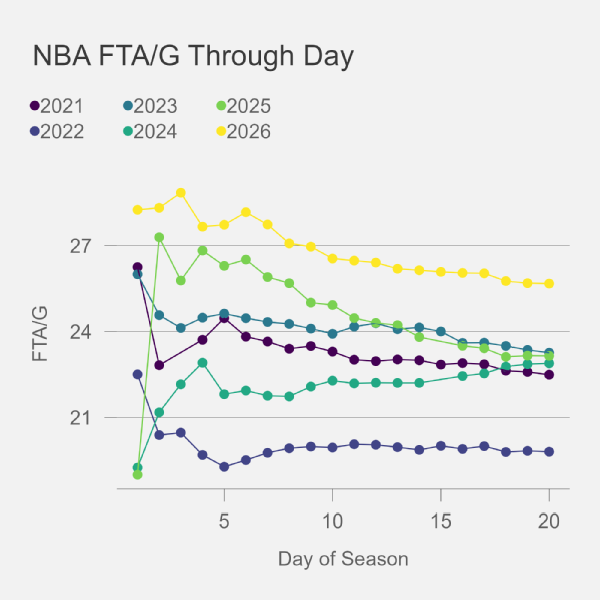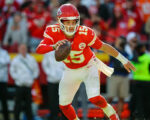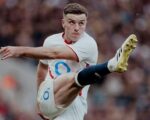In the initial month of the NBA season, discerning genuine trends from those that will not endure through an 82-game regular season is challenging. A year ago, the Phoenix Suns were among the league’s leading early teams with an 8-2 record. In contrast, the Milwaukee Bucks began at 2-8, trailing the Brooklyn Nets by three wins in the Eastern standings.
Such unexpected early starts shouldn’t lead us to dismiss everything witnessed at the beginning of a season. After all, the Cleveland Cavaliers’ unbeaten start last year and the Houston Rockets transitioning from the lottery to near the top of the Western standings proved to be lasting signs.
Not all surprising performances are equivalent, and closely examining aspects that tend to be more stable (such as shot quality) in contrast to those that may fluctuate quickly (like shooting accuracy) can aid in discerning what’s authentic and what’s merely superficial.
With this in consideration, let’s delve into six early trends — featuring the fast-initiating Chicago Bulls and Detroit Pistons, the Rockets and Dallas Mavericks at opposite ends of the offensive landscape, and Ajay Mitchell‘s notable second season — to render judgments on whether these trends will endure.
Jump to a trend:
Pistons leading in the East?
Bulls are Reviving
Houston doesn’t miss VanVleet
Mavs struggle to score
Ajay Mitchell shines
Free throw attempts stay elevated

![]()
A six-game winning run has propelled Detroit to the top of the Eastern standings. Realistically, the Pistons can’t jump as high as last season, when they improved by 30 wins and recorded a playoff win for the first time since 2009, but another hike without veteran guard Malik Beasley would solidify Detroit’s youthful base as a future powerhouse in the East.
Verdict: Genuine, and impressive
Although Cade Cunningham (25.6 PPG, 9.8 APG) and Jalen Duren (a career-high 19.4 PPG, up from 11.8 last season) are achieving extraordinary offensive statistics, the Pistons’ accomplishments have been based on the defensive side, ranking fourth in defensive efficiency.
These results align with the fundamental process. Only the Oklahoma City Thunder are forcing tougher shots than the Pistons according to GeniusIQ’s measured shot probability metric. Shot probability attempts to predict the expected eFG% based on shot location, shot type, proximity of defenders, and player ability.
Detroit is permitting the fourth-fewest shots per 100 possessions in the restricted area near the basket, as per GeniusIQ, and limiting opponents to the league’s lowest shooting percentage on those shots (55.7%). Maintaining this performance might prove challenging since no team allowed less than 63.6% last year, but the Pistons can endure some defensive regression and still remain near the top of the East. After all, Detroit is genuinely underperforming its shot quality on offense, where Tobias Harris is shooting an effective 45.1%, down from 53% last year.
The history of teams regressing after such significant improvements as the Pistons achieved last season was one reason my statistics-based forecasts were relatively low on them heading into this season.
Historically, teams exceeding their expected win total by at least 15 games (and Detroit was 18.5 games better) have experienced a drop-off of around four wins in the subsequent season since 2000. However, the last two teams to fit this category (the 2021-22 Cavaliers and 2022-23 Thunder) both improved again, prompting a reconsideration of this traditional perspective.
![]()
After trading away Zach LaVine before the 2025 deadline, the Bulls were considered afterthoughts heading into this season. Chicago’s over/under win total of 34.5 on ESPN BET ranked as the eighth lowest in the league. Yet the Bulls were the last unbeaten team in the East, starting 5-0. Could Chicago be an unlikely contender?
Verdict: Not genuine
Unfortunately, an inspection revealed the Bulls’ start was not sustainable. In the first seven games of the season, Chicago managed the remarkable feat of outperforming their anticipated shooting more than any other team using quantified shot probability while simultaneously experiencing the most underperformance by their opponents’ shooting.
Considering player capability is crucial when assessing shots on offense, where a Josh Giddey catch-and-shoot three-pointer carries less value than one taken by Stephen Curry, even though Giddey has shot a better percentage from beyond the arc this season (38.5%).
Based on weighted attempts this season, considering career 3-point percentages, we would expect the Bulls to be shooting 35.5% from three. Instead, they are hitting 39.7%. During Chicago’s 5-0 start, opponents shot merely 30% from three. Since then, teams have shot an impressive 41% as the Bulls have come back to Earth with three losses in their last four games.
Chicago secured early victories without starting guard Coby White, who has yet to participate due to a calf strain. However, the Bulls’ potential has not shifted as drastically as the standings from one week ago might have indicated.
![]()
Operating without a traditional point guard after starter Fred VanVleet sustained a season-ending ACL tear before training camp, the Rockets still showcase the NBA’s top offensive rating at 121.7 points per 100 possessions, nearly seven points more than their output last season while concluding second in the West.
Referring back to weighted career 3-point percentage, Houston has surpassed this mark more than any team in the league. The Rockets’ shooters boast a weighted career percentage of 34%, ranking third lowest in the NBA. Yet, Houston’s 43% shooting from three is comfortably the best.
1:14
Houston Rockets vs. Milwaukee Bucks: Game Highlights
Houston Rockets vs. Milwaukee Bucks: Game Highlights
Verdict: Mostly not genuine
Positively, the Rockets aren’t exceeding their overall shot quality to the same extent as Chicago has. Inside the arc, Houston has likely been unfortunate in the early stage. Amen Thompson‘s two-point shooting has dropped from 60% to 53%, while Kevin Durant is only making 52% of his two-pointers after converting at 57% last year.
Moreover, the Rockets don’t need to shoot efficiently to thrive offensively. They lead the NBA by grabbing 37% of available offensive rebounds, with no other team surpassing 33%. Acquiring Durant has allowed Houston to secure the NBA’s fourth-best free throw rate. Therefore, even in VanVleet’s absence, they project as a better offense this season, albeit not to the level we’ve witnessed so far.
![]()
We anticipated Dallas would encounter some difficulties offensively until Kyrie Irving recovers from his ACL tear, especially after coach Jason Kidd opted to deploy No. 1 draft pick Cooper Flagg out of position at point guard to start the season. However, no one would have expected the Mavericks to rank as the second-worst offense in the league three weeks in, trailing the rebuilding Brooklyn Nets by over seven points per 100 possessions.
Dallas has performed better with veteran D’Angelo Russell at the point guard position. Units with Russell have ranked in the 15th percentile for offensive effectiveness league-wide, according to Cleaning the Glass, compared to the third percentile when he is absent. However, the Mavericks’ defeat in Russell’s initial start against the struggling New Orleans Pelicans was a reminder that he is not the ultimate solution for offensive struggles.
Verdict: Concerningly genuine until Irving is back
Data from GeniusIQ indicates Dallas is underachieving relative to its expected shot quality by the third-highest margin in the league. In contrast to the Rockets, the Mavericks aren’t compensating with second-chance opportunities. Despite the large lineups, Dallas is capturing only 24.7% of offensive rebounds.
Starting Russell should at least help the Mavericks minimize critical turnovers. Lineups without either Russell or backup point guard Brandon Williams are committing turnovers 20% of the time, per Cleaning the Glass. Experimenting with a teenager unaccustomed to point guard duties in significant games is particularly challenging with opposing teams increasing their ball pressure following last year’s playoffs.
Ultimately, true offensive success is unlikely until they secure Irving’s return. He has demonstrated effective shooting at 57% during his tenure in Dallas, significantly more efficient than Russell, whose career average of 51% has declined during the last two seasons.
![]()
With Oklahoma City standout Jalen Williams sidelined due to wrist surgery followed by a procedure to remove a screw from the wrist, the Thunder have leaned heavily on second-year guard Ajay Mitchell. Initially signed under a two-way deal as a second-round draft choice, Mitchell contributed during his rookie year, but he has elevated his scoring average by over ten points to 17.2 PPG across the season’s first 11 contests.
Nothing appears unduly coincidental in Mitchell’s statistics. His most significant enhancement is a prominent increase in his usage rate from 16% as a rookie to 26%, ranking second among Oklahoma City players after MVP Shai Gilgeous-Alexander.
Verdict: Genuine as long as the ball is in Mitchell’s hands
Williams’ eventual return will undoubtedly alter Mitchell’s role. He has controlled the ball about 30% of the time on offense this season, according to data from NBA Advanced Stats, compared to 23% last year. Playing an off-ball position alongside Williams on the Thunder’s second unit during Gilgeous-Alexander’s rest periods, Mitchell’s opportunities as a creator will diminish, and his three-point shooting will come under greater scrutiny.
The positive for Oklahoma City coach Mark Daigneault is that Mitchell’s rise may enable him to rest both Gilgeous-Alexander and Williams at once, rather than needing to keep one on the court during critical situations. This might help manage their playtime and preserve their stamina for the playoffs while also providing Mitchell an opportunity to excel.
Free throw attempts maintain elevation
I addressed this trend a week into the season, and while the raw figures have slightly decreased, there is now further evidence to suggest this is a legitimate trend with additional weeks of data. Over the first 20 days of the season, teams averaged 26 free throw attempts per game, nearly three more than the 2024-25 average at this point and the highest since the 2006-07 season.
Verdict: Genuine, at least until it’s not

This trend is intriguing because there was no expectation for an increase in fouls this season. Players, coaches, and fans appeared pleased with the league’s adjustments during the 2023-24 season to permit greater physicality in response to record-breaking offensive activities.
The NBA’s officiating priorities during the preseason did not signal any strict enforcement, focusing mainly on post-shot contact against jump shooters. However, non-shooting fouls have actually risen more this season (a 25% uptick) compared to shooting fouls (up 15%). Therefore, this does not appear to be the cause.
Increased ball pressure — as teams mimic the achievements seen during last season’s playoffs by the Indiana Pacers and Minnesota Timberwolves — seems to account for part of the increase in non-shooting fouls. Simultaneously, even teams that have lowered their pressure rates are being called for more non-shooting fouls, indicating a shift in officiating practices.
While the free throw rate is not a fluke, it remains complex to predict how the situation will develop as teams and players adjust and the league reacts to feedback. Due to these variables, I’d still wager against so many foul shots continuing in the future.













